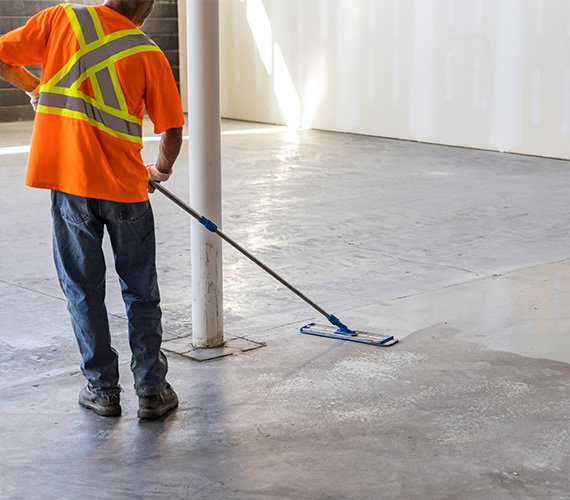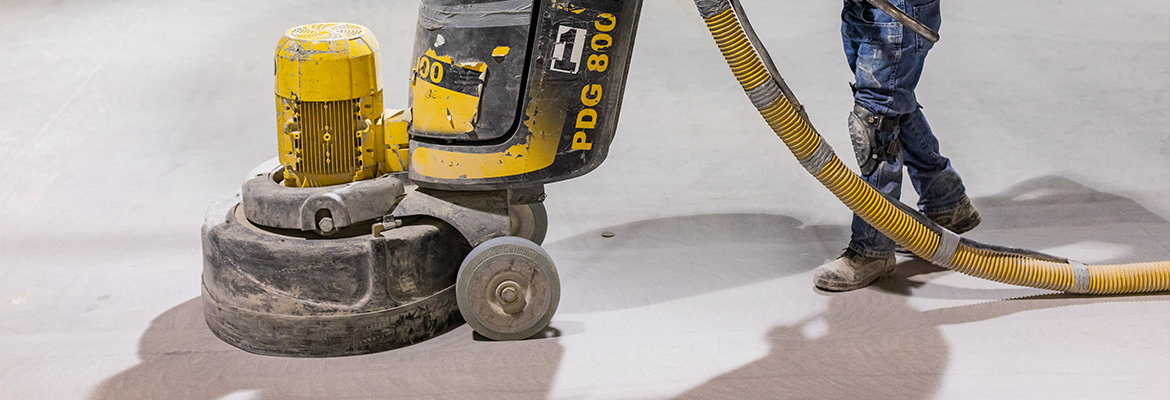Also referred to as hyper-polished floors, concrete floor polishing is one of the most economical and environmentally friendly flooring finishes available.
BNE proudly serves clients across the GTA and throughout Ontario, Canada. We use industry-leading industrial diamonds, hardeners, and sealers for your project. Grinding is performed dry, and our team employs state-of-the-art dust collection systems to keep the work surface and surrounding areas clean.
Not sure which flooring solution is best for your business in the GTA or Ontario?
Speak to one of our experienced sales reps to see what concrete flooring solution would be best for your business.
Permanent dust proofing
Increased reflection of ambient light
No peeling or chipping
No waxing or stripping of floors
Unaffected by UV rays and fading or yellowing
No curing
Resistant to tire wear and tire marks
Ideal for commercial spaces to project a bright and clean professional image
Maintainable with water only, no chemicals being washed down the drains
The floor exists if the concrete slab exists
Allows the floor to breathe, preventing damage to the concrete
No need for adhesives, carpet fibres, isocyanates, and other hazardous chemicals
LEED compatible flooring
Floors do not need to be re-epoxied every few years
Sustainable: you are using the existing concrete floor instead of new flooring
Polishing is a time-consuming process that increases labour costs
Downtime can affect your business
Polished concrete is susceptible to chemical damage and staining
The final finish will dull over time and will require re-buffing and polishing
BNE has a tested and proven methodology for polishing concrete floors serving businesses
across the GTA and throughout Ontario, Canada.
Our customizable 5 step process means that you get the final floor you want for your project.
In most commercial and industrial installations, we aim for a semi-exposed or low-exposed aggregate. Very rarely does a floor need a fully exposed aggregate look. The first cut will determine the final look of the floor and open it up to accept a densifier.
The grinding process will remove any existing covering or finish on the concrete and flatten the floor. Flat floors are important in high-traffic situations, especially heavy fork-lift traffic. Grinding will also remove any curling or lippage at control joints due to concrete heaving.
BNE uses an acrylic grout to fill in air pockets, hairline cracks, and small pinholes to give you a better, cleaner floor with improved clarity. We grind directly over the still wet grout to create a slurry that fills in all the open pores in the concrete surface.
BNE uses a foam squeegee to clean the floor and to remove any extra grout. Beware of contractors using a broom at this stage. A broom would remove the grout from within the cracks and pores and result in a cloudier finish and possible chipping and flaking of the grout.
BNE can use diamond grinders to deep grind the first pass to expose aggregates in the flooring like marble, granite, or terrazzo chips or a lighter surface shave, known as ‘concrete milk’.
Between the grind and the polish, we add a water-based densifier to the concrete to harden it. This is also the stage where we can stain the concrete to a specific colour. Regardless of what you choose, the result is a durable, low maintenance, aesthetically pleasing floor.
Concrete can be stained almost any colour. If you are looking for a uniform colour that covers the entire floor, dyeing your floor is the most cost-effective and optimal solution. View our section on Staining and Polishing for more information on staining.
BNE will ensure that the floor was opened enough to accept the densifier. If it’s not, the densifier won’t penetrate and then the floor won’t be as durable and won’t last as long.
Densifier hardens the cement and the grout we used to fill in the cracks and pores. We can also add chemical additives to increase slip-resistance, impact resistance, and resistance to staining. Densifiers will also improve the abrasion resistance of the flooring.
Once the densifier has hardened, we can move onto polishing the floor. Polishing will create a modern, low maintenance interior design.
We can now use hybrid diamonds, like ceramic, to help remove any random scratching left by using metal bond diamonds in the initial grinding stages.
Expert installers, like the team at BNE, are very good at removing these scratches and we should be able to eliminate all visible scratches. Once we are satisfied that the floor is scratch free, we can begin polishing, working up to the final gloss level you want for your project.
The concrete is ground down over 6-8 passes depending on the final look you want for your project. We start with a 40-grit tooling and finish with 1600-3000 grit. A 3000-grit finish would be comparable to granite or marble flooring at a fraction of the cost.
Your floors will be more slip resistant if they are not highly polished. In most industrial applications we aim for a low to medium gloss finish.
Finally, once we have achieved the polish you want, we apply a guard to the floor. Compared to a topical sealer which just sits on the surface, a guard is a better choice for high-traffic areas. The guard penetrates the concrete surface and only leaves a small residue on the surface.
We can also finish the surface with a topical sealer, but it will need to be heated with a high-speed burnisher to cure. The downside is that the sealer will eventually wear away, especially in high-traffic areas, and will need to be re-applied.
A lot of other concrete finishes can mimic the look of polished concrete. Our consultants can work with you to determine the best finishing solution to ensure the result is what was intended in the original architectural plans.
In the concrete polishing section, we make a brief mention of staining and how it can be used to colour the floor before polishing is completed.
Acid-stained flooring creates a unique floor that accentuates the character of the floor and is an ideal solution for revitalizing faded concrete. Acid-stained floors are a very economical treatment that enhances the natural appearance of concrete to give you the best of both worlds – durability and beauty.
By using Hydrochloric or Phosphoric acid, mixed with salts, and applying it to a hardened and cured concrete floor you can bring out the depth and detail of the concrete. This creates a permanent, flake proof colour that will not fade or peel over time.
The final look of the floor depends heavily on the materials we use in the acid mix, the age and condition of the concrete, and the porosity of the concrete surface. Etching grout lines into the concrete and using acid staining with polishing can create high end floors that replicate the look of marble at a fraction of the cost.
Finally, your stained and polished floors can also be sealed with an epoxy or urethane topcoat to further protect and preserve the finished look. This process will also make your floors easy to maintain, cost effective, and durable.


Concrete floors can be finished with a simple grind and seal. Grinding and sealing can give you a finish very similar to polished concrete. Polished concrete costs more then just grinding and sealing because it takes twice the number of steps to achieve the final finish.
When polishing a floor, we use 6-8 passes with the grinder. When grinding and sealing we only need to go over the floor 3-4 times. We start with the same rough grit, but we finish with a 80-160 grit grind versus 1600-3000 grit final passes when polishing.
A grind and seal floor can be finished in high gloss, satin, or matte. Once we have completed the grinding, the concrete can be stained in a variety of colours, and then sealed with one prime coat and one topcoat of a clear urethane coating.
Like our other epoxy and urethane-based topcoats, we can add traction increasing additives to make the floor more anti-slip. And grind and seal floors are more durable and longer lasting than polished concrete due to the urethane topcoat.
Long term maintenance costs are also very reasonable, as the floor can be restored back to new by just redoing the urethane topcoat.
Speak to your BNE representative in the GTA or Ontario, Canada, to find out if grind and seal floors are the cost-effective and durable solution for your commercial space.
What does polished concrete look like?
Polished concrete has a sleek, modern, and glossy appearance that can be customized to fit various aesthetics. Its look is achieved by grinding the concrete surface and adding a high-gloss finish, revealing a smooth texture with options for exposed aggregate or minimal aggregate visibility. The surface can range from a natural gray tone to stained finishes in different colors, offering a reflective, elegant sheen ideal for residential, commercial, and industrial spaces.
Are polished concrete floors hard to maintain?
No, polished concrete floors are not hard to maintain. They are highly durable and only require regular sweeping and occasional mopping with a pH-neutral cleaner to keep them looking great. For businesses, this means lower maintenance costs and less downtime for cleaning compared to other flooring options.
Are polished concrete floors worth it?
Polished concrete floors are an excellent investment if you value durability, modern aesthetics, and low maintenance. They are particularly suited for industrial, commercial, and contemporary residential spaces.
Can polished concrete be used in bathrooms?
Yes, polished concrete can be used in bathrooms. It is durable, moisture-resistant when properly sealed, and easy to clean, making it a practical and stylish option. Its sleek, modern appearance works well in contemporary designs, and it can be customized with different finishes or anti-slip additives to ensure safety.